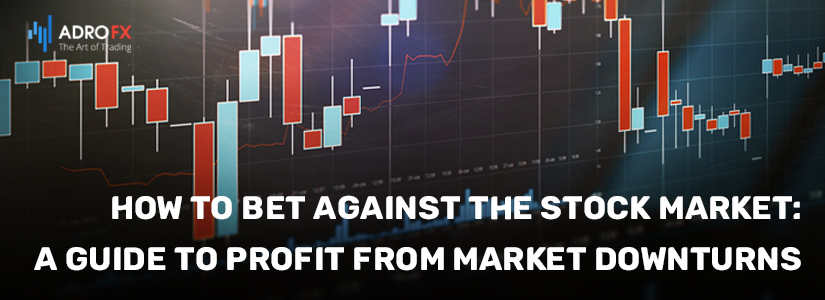How to Bet Against the Stock Market: A Guide to Profit from Market Downturns

In the world of investing, the stock market has historically been perceived as a realm of prosperity, with the potential for significant returns and wealth accumulation. However, as with any financial venture, market downturns are an inevitable reality that can leave investors scrambling to safeguard their portfolios. While most investors aim to capitalize on market upswings, a lesser-known strategy involves betting against the stock market, profiting from its declines.
This article delves into the art of betting against the stock market, commonly known as short selling or bearish investing. By employing this technique, savvy traders seek to capitalize on falling stock prices and economic downturns. Throughout this guide, we'll explore the fundamentals of short selling, the various methods to implement it, and the potential risks and rewards associated with this alternative approach.
For those looking to expand their investment horizons and better protect their portfolios in times of market turmoil, learning how to bet against the stock market can prove to be an invaluable skill. So, let's embark on this educational journey, arming you with the knowledge and insights to navigate the complexities of bearish investing with confidence and proficiency.
What Is Betting Against the Market?
Betting against the stock market, also known as short selling or bearish investing, is a strategy employed by traders and investors to profit from falling stock prices. While traditional investing involves buying stocks with the expectation that their value will rise over time, short selling flips this approach on its head, allowing individuals to capitalize on market downturns.
In a short selling transaction, an investor borrows shares of stock from a brokerage and immediately sells them on the open market. The investor is essentially betting that the stock's price will decline. If the stock price indeed drops, the investor can repurchase the shares at the lower price, return them to the brokerage, and pocket the difference as profit.
Let's walk through an example to illustrate how short selling works:
- Initial Borrowing: An investor believes that Company XYZ's stock, currently trading at $100 per share, is overvalued and will decline. The investor borrows 100 shares of Company XYZ from their brokerage.
- Selling Short: The investor sells the borrowed shares of Company XYZ on the market at the current price of $100 per share, for a total of $10,000.
- Market Downturn: As anticipated, Company XYZ's stock price experiences a decline and falls to $80 per share.
- Closing the Short Position: The investor decides to close their short position to realize their profit. They buy back 100 shares of Company XYZ at the current price of $80 per share, spending $8,000.
- Profit Calculation: The investor returns the borrowed shares to the brokerage. Their total cost to repurchase the shares was $8,000, but they initially received $10,000 when selling short. Thus, the investor's profit from short selling Company XYZ's stock is $2,000.
Short selling can be an effective strategy during bear markets, economic downturns, or when specific stocks are overvalued or facing significant challenges. It provides investors with an opportunity to benefit from downward market movements, diversify their investment approaches, and potentially hedge their long positions during turbulent times.
However, it's crucial to recognize that short selling carries higher risks compared to traditional investing. Unlike buying a stock, where the maximum loss is the initial investment, short selling losses can theoretically be unlimited since stock prices can rise indefinitely.
As with any investment strategy, short selling requires a comprehensive understanding of the market dynamics, diligent research, and risk management. Traders should be aware of potential margin calls from their brokerages, which may require additional funds if the stock price moves against their short position.

Ways to Bet Against the Market
Betting against the stock market, also known as short selling or bearish investing, allows traders to profit from declining stock prices and economic downturns. While short selling is one approach to bet against the market, there are other strategies that investors can consider to capitalize on bearish trends. Let's explore some popular ways to bet against the market:
Short Selling
Short selling, as described earlier, involves borrowing shares from a brokerage, selling them on the market, and buying them back at a lower price to profit from the price difference. Short selling is typically done with individual stocks, but it can also apply to exchange-traded funds (ETFs) and other securities.
Put Options
Put options grant investors the valuable right, though not the obligation, to sell a specific stock or ETF at a predetermined price, known as the strike price, within a specified period until the option's expiration date. This financial instrument allows investors to capitalize on a decline in the underlying stock's price below the strike price. One of the key advantages of buying put options is that it offers a limited-risk bearish strategy. The maximum loss incurred by the investor is restricted to the premium paid for purchasing the options. In other words, investors have the potential to profit from a falling stock price without facing the risk of unlimited losses that are associated with short selling or other bearish strategies. By utilizing put options strategically, investors can safeguard their portfolios during market downturns while retaining the flexibility to exit the position if market conditions change.
Inverse ETFs
Inverse exchange-traded funds (ETFs) are designed to move in the opposite direction of the benchmark index they track. For example, if an investor believes that the S&P 500 will decline, they can invest in an inverse S&P 500 ETF, which aims to rise when the S&P 500 falls. Inverse ETFs provide a straightforward way to bet against the broader market without the complexities of short selling individual stocks.
Shorting Index Futures
Futures contracts allow investors to speculate on the future price of an underlying asset, such as a stock index. By shorting index futures, investors can profit from a decline in the overall market as represented by the index. However, trading futures carries additional risks and complexities, and it may not be suitable for inexperienced traders.
Bearish Option Strategies
Various bearish option strategies can be employed to profit from declining stock prices or increased market volatility. Examples include buying long puts, bear call spreads, and protective collars. These strategies combine options to achieve specific risk and reward profiles based on market expectations.
Shorting Currency or Commodity ETFs
In addition to betting against stocks, investors can also take bearish positions in currency or commodity ETFs. For instance, if an investor expects the value of a particular currency or commodity to decline, they can short the corresponding ETF to profit from the anticipated price decrease.
Before engaging in any bearish investment strategy, it is essential to conduct thorough research, consider risk management techniques, and be aware of potential losses. Betting against the market can be profitable during downturns, but it also carries higher risks and requires a comprehensive understanding of the selected strategy and its potential consequences. Consulting with a financial advisor can help investors navigate these complex strategies and make well-informed decisions to enhance their overall investment approach.

What Is the Best Way to Short the Market?
The best way to short the market depends on an investor's risk tolerance, investment objectives, and level of expertise. Shorting the market can be profitable during bearish trends, but it involves higher risks and complexities compared to traditional long positions.
Before choosing the best way to short the market, investors should thoroughly research and understand the risks associated with each strategy. Shorting the market requires careful risk management and timely execution, as losses can escalate rapidly if the market moves against the short position.
Is Buying a Put the Same as Shorting?
While both buying a put option and shorting a stock are bearish strategies that aim to profit from a decline in the price of the underlying asset, they differ in their mechanics and risk profiles.
Shorting a Stock
This strategy involves borrowing shares from a brokerage and selling them on the open market with the expectation of buying them back at a lower price in the future. The investor is essentially betting that the stock's price will decline. If the stock price indeed drops, the investor can repurchase the shares at the lower price, return them to the brokerage, and pocket the difference as profit. However, short selling carries the risk of unlimited losses if the stock price rises significantly, as there is no upper limit to how high the stock price can go.
Buying a Put Option
On the other hand, buying a put option is a type of options contract that gives the holder the right, but not the obligation, to sell the underlying asset (such as stock) at a predetermined price (strike price) within a specified period (until expiration). By purchasing a put option, the investor pays a premium to the option seller. If the underlying asset's price drops below the strike price during the option's validity period, the investor can exercise the put option and sell the asset at the higher strike price, thereby profiting from the decline in the asset's price. The maximum loss for the investor is limited to the premium paid for the put option.
In summary, shorting involves borrowing and selling an asset with the hope of buying it back at a lower price, while buying a put option involves purchasing the right to sell an asset at a predetermined price, aiming to profit from a decline in the asset's price. Both strategies can be used to benefit from bearish market movements, but they have distinct characteristics and risk considerations. Shorting entails potentially unlimited losses, while buying a put option offers a limited-risk bearish strategy with a defined maximum loss. It is essential for investors to carefully assess their risk tolerance and understanding of these strategies before incorporating them into their investment approach.
Summary
This comprehensive article serves as a guide to bet against the stock market, offering valuable insights into short selling and other bearish investment strategies. It explores the fundamentals of short selling, providing a step-by-step example to illustrate how the process works. The article also delves into alternative ways to profit from market downturns, including buying put options, using inverse ETFs, shorting index futures, employing bearish option strategies, and shorting currency or commodity ETFs. The importance of thorough research, risk management, and consultation with financial advisors is emphasized throughout the article. By arming readers with knowledge and understanding, the article aims to equip investors with the skills to navigate bearish investing confidently and protect their portfolios during turbulent times.
About AdroFx
Established in 2018, AdroFx is known for its high technology and its ability to deliver high-quality brokerage services in more than 200 countries around the world. AdroFx makes every effort to keep its customers satisfied and to meet all the trading needs of any trader. With the five types of trading accounts, we have all it takes to fit any traders` needs and styles. The company provides access to 115+ trading instruments, including currencies, metals, stocks, and cryptocurrencies, which make it possible to make the most out of trading on the financial markets. Considering all the above, AdroFx is the perfect variant for anyone who doesn't settle for less than the best.










